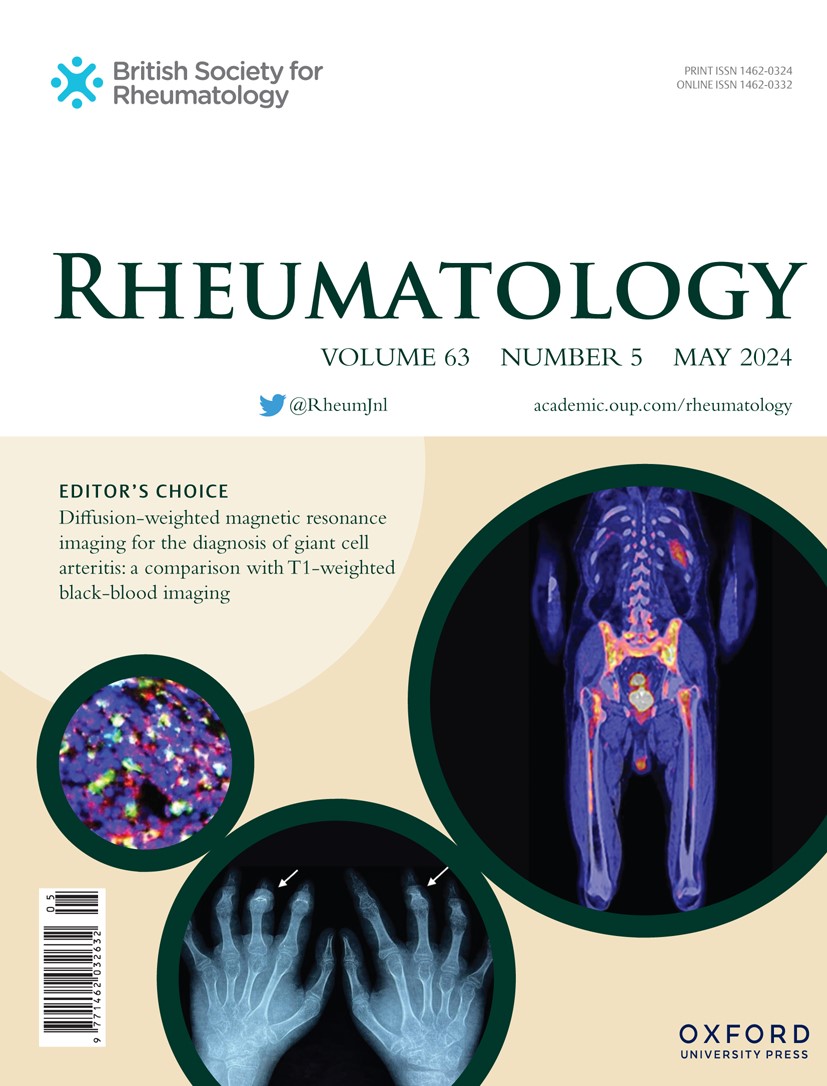P077 Can we predict who responds to intra-articular corticosteroid injection in knee arthritis? A clinical trial comparing response in inflammatory arthritis and osteoarthritis
IF 4.7
2区 医学
Q1 RHEUMATOLOGY
引用次数: 0
Abstract
Background/Aims The global burden of knee arthritis is significant and rising. Patients can experience pain and disability over a long duration. Intra-articular corticosteroid injections (IACI) can reduce inflammation and pain in arthritis. However, there is disparity in pain reduction and efficacy duration following IACI. We aimed to identify factors that influence IACI response in knee osteoarthritis (OA) and inflammatory arthritis (IA), to aid stratification of future patients. Methods In this multi-centre prospective study, participants with knee OA and IA (rheumatoid, psoriatic or mixed arthritis on standard treatment) were recruited. At baseline, demographics, DAS28, PsARC, painDETECT and Western Ontario and McMasters Universities Arthritis Index (WOMAC) for pain, stiffness and function were completed. We classified painDETECT scores with ≥19 “sensitised” and ≤18 “non-sensitised” for pain. Sonographic assessment and IACI was performed, with synovitis/effusion categorised dichotomously (present/absent). Two musculoskeletal radiology consultants graded knee radiographs as low Kellgren-Lawrence grade 0-2 (LKLG) or high grade 3-4 (HKLG). At 3 months, all questionnaires were repeated. IACI response was defined as 20% improvement from baseline WOMAC pain. Differences between responders/non-responders were assessed using Wilcoxon (continuous variables) and Fisher’s exact tests (categorical variables). Analysis was conducted in R. Results There were 129/136 patients recruited who had IACI: 89 were analysed (62 OA, 27 IA) (Table 1), with 40 lost to follow-up. Irrespective of arthritis pathology, odds of IACI response among sensitised versus non-sensitised participants was 0.33(p = 0.051). In the LKLG-OA cohort, responders had significantly lower baseline painDETECT scores than non-responders (p = 0.015); 10/14 (71%) non-sensitised responded to IACI, compared with 0/6 (0%) of the sensitised. No difference in baseline painDETECT scores between responders and non-responders in the HKLG-OA cohort(p = 0.50) or in either inflammatory cohort(LKLG p = 0.86, HKLG p = 0.77) was detected. In the OA-synovitis/effusion cohort, responders had lower baseline painDETECT scores; while this was not statistically significant (p = 0.13), 0/6 (0%) of sensitised participants responded, versus 17/33 (52%) non-sensitised patients. Conclusion Our study suggests imaging and clinical measures can predict IACI response, with pain sensitisation conferring lower likelihood of response, particularly in OA with LKLG. Following validation studies, design of a predictive clinical model could allow patient stratification for personalised treatment, reducing IACI waiting times and optimising resource allocation. Disclosure A. Paterson: None. K. Feather: None. A. Lambarth: None. M. Siebachmeyer: None. V. Ejindu: None. F. Howe: None. A. Rudnicka: None. A. Ezeonyeji: None. R. Ramsden: None. N. Sofat: None.P077我们能否预测膝关节关节炎患者谁对关节内皮质类固醇注射有反应?一项比较炎性关节炎和骨关节炎疗效的临床试验
背景/目的膝关节关节炎的全球负担显著且呈上升趋势。患者可能会在很长一段时间内经历疼痛和残疾。关节内皮质类固醇注射(IACI)可以减轻关节炎的炎症和疼痛。然而,IACI后疼痛减轻和疗效持续时间存在差异。我们旨在确定影响膝关节骨关节炎(OA)和炎症性关节炎(IA)患者IACI反应的因素,以帮助对未来患者进行分层。方法在这项多中心前瞻性研究中,招募了患有膝关节OA和IA(类风湿、银屑病或混合关节炎,接受标准治疗)的参与者。基线时,完成人口统计学、DAS28、PsARC、painDETECT和Western Ontario and McMasters Universities Arthritis Index (WOMAC)的疼痛、僵硬和功能评估。我们将painDETECT评分分为≥19“敏感”和≤18“非敏感”。超声评估和IACI,将滑膜炎/积液分为两类(有/无)。两名肌肉骨骼放射学顾问将膝关节x线片分级为低kelgren - lawrence分级0-2 (LKLG)或高分级3-4 (HKLG)。3个月时,再次进行问卷调查。IACI缓解定义为比基线WOMAC疼痛改善20%。使用Wilcoxon(连续变量)和Fisher精确检验(分类变量)评估应答者/无应答者之间的差异。结果纳入的136例IACI患者中有129例进行了分析,其中89例进行了分析(OA 62例,IA 27例)(表1),其中40例失访。无论关节炎病理如何,致敏者与非致敏者IACI反应的几率为0.33(p = 0.051)。在LKLG-OA队列中,应答者的基线painDETECT评分显著低于无应答者(p = 0.015);非致敏组10/14(71%)对IACI有应答,而致敏组为0/6(0%)。在炎症组(LKLG p = 0.86, HKLG p = 0.77)中,应答者和无应答者的基线painDETECT评分均无差异。在oa -滑膜炎/积液队列中,应答者的基线painDETECT评分较低;虽然这没有统计学意义(p = 0.13),但0/6(0%)的致敏参与者有反应,而17/33(52%)的非致敏患者有反应。结论:我们的研究表明,影像学和临床措施可以预测IACI的反应,而疼痛致敏会降低反应的可能性,特别是在患有LKLG的OA患者中。在验证研究之后,预测临床模型的设计可以允许患者分层进行个性化治疗,减少IACI等待时间并优化资源分配。A.帕特森:没有。K.羽毛:没有。A. Lambarth:没有。西巴赫迈耶:没有。V. Ejindu:没有。F. Howe:没有。A. Rudnicka:没有。A. Ezeonyeji:没有。拉姆斯登:没有。索菲特:没有。
本文章由计算机程序翻译,如有差异,请以英文原文为准。
求助全文
约1分钟内获得全文
求助全文
来源期刊

Rheumatology
医学-风湿病学
CiteScore
9.40
自引率
7.30%
发文量
1091
审稿时长
2 months
期刊介绍:
Rheumatology strives to support research and discovery by publishing the highest quality original scientific papers with a focus on basic, clinical and translational research. The journal’s subject areas cover a wide range of paediatric and adult rheumatological conditions from an international perspective. It is an official journal of the British Society for Rheumatology, published by Oxford University Press.
Rheumatology publishes original articles, reviews, editorials, guidelines, concise reports, meta-analyses, original case reports, clinical vignettes, letters and matters arising from published material. The journal takes pride in serving the global rheumatology community, with a focus on high societal impact in the form of podcasts, videos and extended social media presence, and utilizing metrics such as Altmetric. Keep up to date by following the journal on Twitter @RheumJnl.
 求助内容:
求助内容: 应助结果提醒方式:
应助结果提醒方式:


